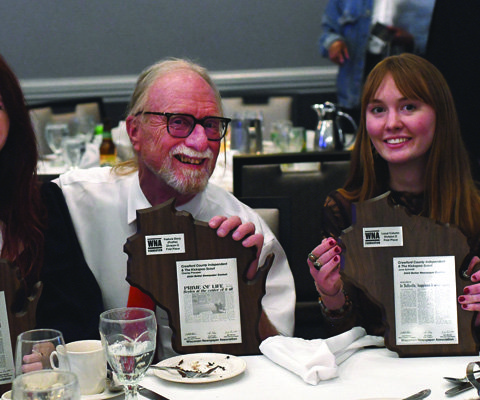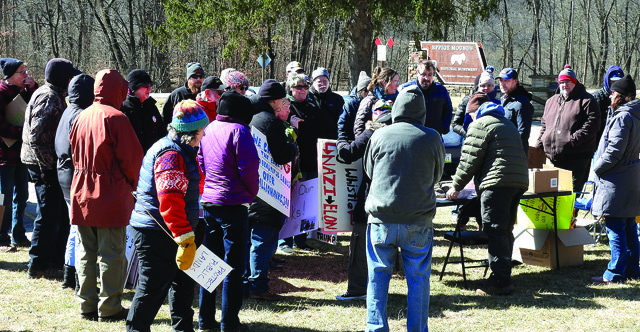DRIFTLESS - There was an auspicious moment at the press conference of the Organic Valley Annual Meeting last week, when CEO George Siemon calmly told those present that the cooperative had suffered it first annual loss in 20 years. It was a moment you could see and feel the maturity of the business that had been reached in its 30 years of growth.
Earlier in the press conference, Organic Valley’s Director of Marketing Lewis Goldstein, as well as Siemon, had discussed the maturing of the company. Goldstein had even joked about finally understanding Siemon’s statement that the co-operative was a “social experiment disguised as a business.”
Siemon explained that an oversupply of organic milk, like the oversupply of conventional milk, had impacted demand and resulted in lower prices. Organic Valley, which is most heavily reliant on its dairy production for income, was heavily impacted.
Lowering dairy pay prices to farmers earlier in the year probably would have avoided what turned out to be a $10.6 million loss for co-op in 2017, according to Siemon. Organic Valley had raised its pay price for farmers to over $34/cwt. in 2014-15, as the co-op competed with a very high conventional price. As the conventional price fell, OV never lowered that price. In response to the current situation, the co-operative has twice lowered the price by $2/cwt.
The current average Midwest price is $29.70/cwt., which compares to a current average conventional price for Class Three milk of $13 to $14/cwt.
Looking back at 2017, OV’s national average pay price to dairy farmers was $32.85/cwt., while the conventional average dairy pay price was $17.40/cwt.
Despite recording their first loss in 20 years in 2017, Organic Valley continued to have gross sales over $1.1 billion.
The co-op celebrating its 30-year anniversary this year seems to be in fine shape in many ways. The co-operative currently has 2,044 family farms in 35 states, Canada, Australia and the United Kingdom. That represents 14.4 percent of all U.S. certified organic farms.
The co-operative increased sales by 4.2 percent in 2017 over 2016, but that fell short of the plan to grow sales by 10.4 percent over 2016.
“We continued to face significant pricing pressures this year as a result of market consolidation in the organic industry, coupled with low conventional farm prices,” OV’s Chief Financial Officer wrote in the co-op’s annual report. “This forced us to increase our sales discounts and allowances by over $25 million from the 2016 level (of note is that 2016 was 71.5 percent over 2015). Even with the increased allowances and our 4.2 percent growth in sales, we still fell short our plan to grow sales by 10.4 percent over 2016, thus resulting in selling more (organic) milk conventionally.”
So in addition to a sales shortfall and the continued need to discount prices to meet pricing pressures and the need to sell milk conventionally, the chief financial officer cited another half dozen hard to predict factors that impacted the co-op’s financial picture in 2107. They included:
• conventional skim price decline
• growing competition with a variety of “healthy, non-GMO, all natural” options
• one of the co-op’s largest customers, Stonyfield, was sold in order to meet Department of Justice conditions of the White Wave sale to Danone
• continued worldwide oversupply of non-fat dry milk powder, which caused further deterioration in conventional prices
• delays in startups on new, lower-cost manufacturing sites
• transportation shortages, which drove up costs.
All that being said, Porema, the chief financial officer, remained optimistic looking to the future, as did the President of the Board Arnie Trussoni, a dairy producer from Genoa, Wisconsin.
“Now it’s catch-up time,” Trussoni wrote in his statement in the annual report. “We turned the numbers right-side up in November and December, we decreased inventory, and plans are on the table to maximize utilization. These are good signs.
“We are family, and we don’t leave one another behind,” Trussoni wrote. “That’s what our co-operative is all about. I can’t be thankful enough to everyone for chipping in, getting it done and weathering this rough patch together.”
Trussoni’s optimism was definitely on display at the press conference, as well, where Siemon announced Organic Valley was building a cheese processing plant in the state of Oregon and building a cheese cutting facility and ghee butter manufacturing plant in Cashton.
“We will have the largest Ghee factory in the country,” Siemon announced. Ghee is a clarified butter and is a favored method of using butter as a cooking oil.
There was other good news in the room as well. The Organic Valley Grass-fed Dairy and Meat program is also rapidly expanding. On hand for the press conference were two grass-fed dairy producers Ron Holter from Maryland and Kelly Placke from Cuba City.
Teresa Marquez, the former director of marketing and more recently mission executive, was quick to cite a recent study lauding grass-fed milk for the amount of important Omega-3 fatty acids it contains.
Grass-fed milk has 147 percent more Omega-3 than conventional, according to the study.
Holter said his decision to switch to an all-grass and forage diet for his dairy cows was made in 2007 and was based on the fact that cows were made to eat grasses and not grains.
For Kelly Placke her arrival in the grass-fed organic dairy world involved coming home to the farm in Cuba City. Like other millennials, Placke left the family organic diary farm in pursuit of other things. She taught art in Phoenix, Arizona. But came to feel she was missing something so she started working on organic farms.
When she called home from a goat farm in France one day and her mother described all the work they had to do on the farm in Cuba City, Kelly knew it was time to go home. Now, she milks 36 cows that are not only organic but also grass-fed through a change her dad made a few years back before she came home.
To hear Kelly Placke tell it she wouldn’t have it any other way. Her father switched from many years of organic production to grass-fed organic production four years ago.
“I never thought I’d love milking 36 cows, but I do,’ and like Holter she’s a believer in the goodness of grass for cows.
Maybe it was the mood of the event—the mature business in its first year showing loss on the books in 20 years. Somehow, there was calmness in the room during the press conference.
In answer to questions that are sometimes heard now about integrity of the organic industry, both Goldstein and Siemon took issue with that opinion.
Siemon explained that internal arguments among producers and processors about organic standards are sometimes misinterpreted and blown out of proportion when they are reported in the press. He described the organic crowd as an idealistic group with a proclivity to argue about the standards.
However, he was quick to acknowledge that the recent dust-up over relaxing rules allowing egg-producing chickens true outside access was a real problem. The Organic Valley CEO said there was widespread agreement among poultry producers and many others that clarifying the outside access requirement, as was done by the USDA in 2017, was widely supported.
The reversal of that rule by recent UDA action involved politics in Siemon’s opinion and the desires of a few large egg producers to circumvent the true intent of the rule.
Goldstein spoke to another issue that can cloud the idea of organic integrity. He pointed out that at times, but not that often, producers and processors are found to be violating the organic rules and standards and corrective action is taken. He said that can have a negative appearance, but it shouldn’t because it shows the standards are being enforced.
Both Siemon and Goldstein agreed that Organic Valley has standards that exceed the national organic standards. The OV executives believe that building their brand and showing the standards and transparency involved is important going forward.
“That’s why brands are important,” Siemon said.
Siemon, the aging statesman of organics, also made some other candid statements of interest during the press conference.
“I think that small farmers have to go organic or they will be forced out,” Siemon said of smaller producers who are faced now with the lower conventional price.
“I think going forward the number one issue is animal welfare,” Siemon said at another point.
Siemon went on to explain that industrial agriculture was out of tune with what the American consumer wanted. The Organic Valley CEO explained consumers would not be comfortable with what is being done in industrial agriculture, noting it was “not a healthy system.”









